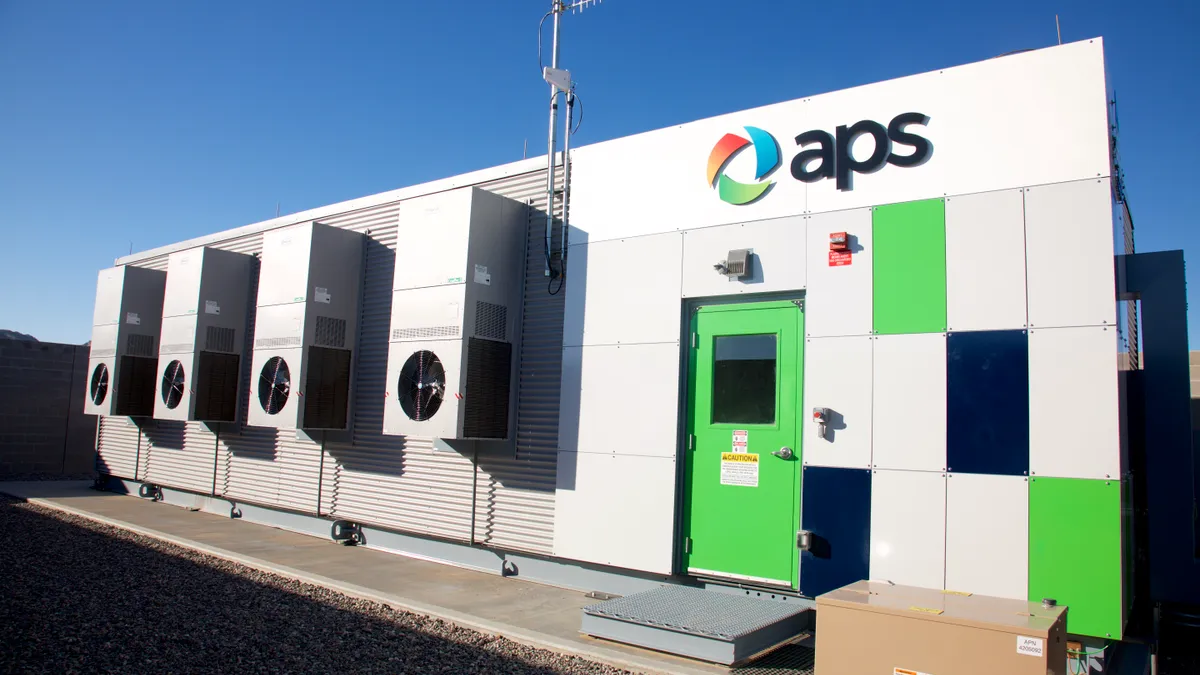Utilities across the country are increasingly turning to energy storage. The technology is vital as it turns power generated by non-dispatchable energy sources, such as wind and solar, into dispatchable ones, improving grid reliability and allowing the integration of even more renewable capacity.
However, there are some concerns regarding the safety of large-scale energy storage facilities, in particular those using lithium-ion batteries.
A recent explosion at an Arizona Public Service (APS) facility that sent four fire fighters to the hospital highlighted those concerns, though the exact cause of the accident remains under investigation.
"The question of how you manage these things safely, when you've got thousands of these cells in close proximity, that's still a work in progress," Donald Sadoway, a professor at the Massachusetts Institute of Technology and an expert in battery technology, told Utility Dive.
APS, the largest investor-owned utility in Arizona, has been a leader in the procurement of energy storage. In February, the utility announced that it will add 850 MW of battery storage and at least 100 MW of solar generation by 2025. Despite the incident at its McMicken facility, the utility plans to follow through with its plans.
"As far as we are concerned, we know that energy storage, including batteries, is vital to a clean energy future. We will continue with our plans to add clean energy projects to our system," Lily Quezada, APS spokesperson, said. "[It] is a breakthrough technology that is solving important issues and challenges. We are still committed to our plans."
Concerns in the industry
The fire at its storage facility in Surprise, Arizona was not the first such incident for APS. Back in 2012, a 1.5-MW system near Flagstaff, Arizona also caught fire. The utility said it took several key design lessons from the 2012 fire, including improving air ventilation between cabinets, incorporating a 24/7 monitoring system and the ability to send remote alarms.
"During the five years between the Elden Battery incident and our next battery system coming online in 2017, battery technology made significant advancements in design and safety standards. The technical lessons learned from that 2012 incident were helpful to that, which shows the importance of fully investigating the cause of the McMicken equipment failure in order to help the industry learn and continue advancing solutions and improvements," Quezada said.
Safety is a concern and a high priority among industry stakeholders. The Energy Storage Association earlier this month launched an initiative to make safety a priority when manufacturing and operating energy storage systems. A total of 30 companies, including GE Energy Storage, Duke Energy and NEC, formerly known as Nippon Electric Company, have signed the energy storage corporate responsibility pledge.
"The U.S. energy storage market nearly doubled in 2018 and is expected to double again in 2019, so this marks an ideal time for the industry to demonstrate their commitment to corporate responsibility," ESA CEO Kelly Speakes-Backman said in a statement.
While most industry stakeholders declined to comment on the incident in Arizona, citing a lack of facts, an NEC executive told Utility Dive that the April 19 fire correctly puts greater emphasis on the safety of energy storage systems along with robust protocols for first responders, and highlights the importance of codes and standards.
"Energy storage is safe as long as it's designed and integrated in a responsible manner, and proper training for operators and first responders is provided. It's important that the failure analysis of this incident is made available so that we as an industry can continue to improve our protocols, processes and products," Roger Lin, energy solutions VP of marketing at NEC, said.
Lin believes that the biggest danger associated with energy storage comes from a lack of adherence to best design safety practices and a lack of robust training for first responders.
Ongoing projects
Duke Energy, which plans to install about 400 MW of battery storage over the next 15 years, told Utility Dive that all its current storage sites have an emergency response plan.
"Duke Energy has a decade of experience operating all types of battery storage. We are also working with our vendor companies to make sure our planned projects have proper emergency response instructions and training at the sites," said company spokesperson Randy Wheeless.
Another utility that indirectly had to deal with a battery storage fire was Hawaiian Electric. In 2012, a 15 MW plant burned on Oahu's North Shore. The storage facility was part of the 12-turbine, 30 MW Kahuku wind farm operated by Xtreme Power.
"We pay attention to energy storage developments. Much of the storage envisioned will be operated by contractual partners, so while safety and efficient operations at those projects are important to us, primary responsibility will be with operators. As the Hawaiian Electric Companies bring our storage online, safety will be our own responsibility and a very high priority, as in all our facilities, including offices," Peter Rosegg, spokesman for HECO, told Utility Dive.
The Hawaii Public Utilities Commission earlier this year approved HECO's procurement of renewable energy, including storage. The utility signed contracts for three projects on Oahu, one on Maui Island and two on Hawaii Island that will add 247 MW of solar energy with almost 1 GWh of storage by the end of 2021.
With batteries not only increasing their relevance as a grid asset in the form of energy storage, but also in transportation with the expected rise of electric vehicles, Sadoway said there are two schools of thoughts on how to increase safety.
"One is, let's just keep working on lithium-ion and solve the remaining problems and continue to chase down the cost curve. I don't subscribe to that school of thought; I instead have been working on ABL, anything but lithium. … But it's a very difficult problem because it has to meet the highest of standards, to the lowest of price points. It's the worst possible mix you can have to deal with," Sadoway said.





















